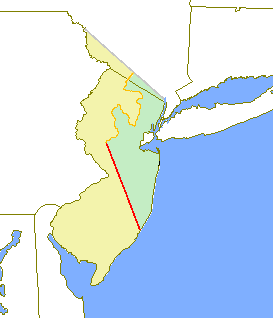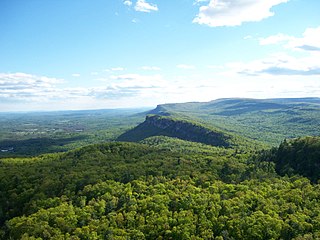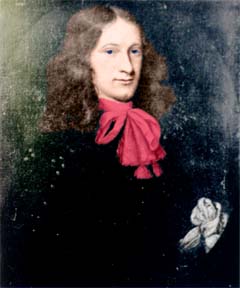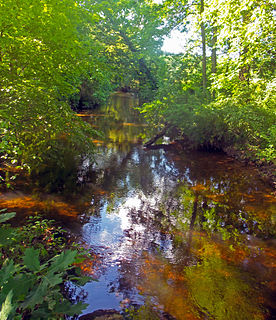Related Research Articles

Wallkill is a hamlet, generally identified as coterminous with ZIP code 12589, telephone exchange 895 in the 845 area code and most of the Wallkill Central School District located mostly in the eastern half of the Town of Shawangunk, Ulster County, New York but partly spilling over into adjacent regions of the Orange County towns of Newburgh and Montgomery. The population was 2,288 at the 2010 census.

The Province of East Jersey, along with the Province of West Jersey, between 1674 and 1702 in accordance with the Quintipartite Deed were two distinct political divisions of the Province of New Jersey, which became the U.S. state of New Jersey. The two provinces were amalgamated in 1702. East Jersey's capital was located at Perth Amboy. Determination of an exact location for a border between West Jersey and East Jersey was often a matter of dispute.

Thomas Dongan, 2nd Earl of Limerick, was a member of the Irish Parliament, Royalist military officer during the English Civil War, and Governor of the Province of New York. He is noted for having called the first representative legislature in New York, and for granting the province's Charter of Liberties.

The Province of Pennsylvania, also known as the Pennsylvania Colony, was founded in English North America by William Penn on March 4, 1681 as dictated in a royal charter granted by King Charles II. The name Pennsylvania, which translates roughly as "Penn's Woods", was created by combining the Penn surname with the Latin word sylvania, meaning "forest land". The Province of Pennsylvania was one of the two major restoration colonies, the other being the Province of Carolina. The proprietary colony's charter remained in the hands of the Penn family until the American Revolution, when the Commonwealth of Pennsylvania was created and became one of the original thirteen states. "The lower counties on Delaware", a separate colony within the province, would break away during the American Revolution as "the Delaware State" and also be one of the original thirteen states.

The Shawangunk Ridge, also known as the Shawangunk Mountains or The Gunks, is a ridge of bedrock in Ulster County, Sullivan County and Orange County in the state of New York, extending from the northernmost point of New Jersey to the Catskill Mountains. Shawangunk Ridge is the continuation of the long, easternmost ridge of the Appalachian Mountains; the ridge is known as Kittatinny Mountain in New Jersey, and as Blue Mountain as it continues through Pennsylvania. This ridge constitutes the western border of the Great Appalachian Valley.
In the United States, a patroon was a landholder with manorial rights to large tracts of land in the 17th century Dutch colony of New Netherland on the east coast of North America. Through the Charter of Freedoms and Exemptions of 1629, the Dutch West India Company first started to grant this title and land to some of its invested members. These inducements to foster colonization and settlement are the basis for the patroon system. In 1775, at the outbreak of the American Revolution, primogeniture and feudal tenure were abolished and thus patroons and manors evolved into simply large estates subject to division and leases.

The Delaware Water Gap National Recreation Area is a 70,000 acres (28,000 ha) protected area designated by the National Recreation Area administered by the U.S. Department of the Interior's National Park Service. It is located along the middle section of the Delaware River in New Jersey and Pennsylvania stretching from the Delaware Water Gap northward in New Jersey to the state line near Port Jervis, New York, and in Pennsylvania to the outskirts of Milford. A 40-mile (64 km) section of the Delaware River, entirely within the National Recreation Area, has been granted protected status as the Middle Delaware National Scenic River under the National Wild and Scenic Rivers System and is also administered by the National Park Service. This section of the river is the core of the historical Minisink region.
Thomas Rudyard was a deputy governor of East Jersey.
Gerardus Willemse Beekman was a wealthy physician, land owner, and colonial governor of the Province of New York.
Francis Rombout was the 12th Mayor of New York City,, from 1679 to 1680. He was one of three proprietors of the Rombout Patent, and father of pioneering Colonial businesswoman Catheryna Rombout Brett.

Orange Lake is located near the hamlet named after it in the Town of Newburgh, New York, United States. At 400 acres (160 ha) in surface area it is the largest lake entirely within Orange County, after which it is named.

The New York – New Jersey Line War was a series of skirmishes and raids that took place for over half a century between 1701 and 1765 at the disputed border between two American colonies, the Province of New York and the Province of New Jersey.

During the American colonial era, the colonies of New York and Connecticut often disputed the precise location of their shared border, leading to a border dispute that eventually gave the colonies their modern shapes. Though the dispute was officially resolved in 1731, effects of the boundary conflict persisted until well after both colonies gained statehood as part of the United States following the American Revolution.

The Minisink or Minisink Valley is a loosely defined geographic region of the Upper Delaware River valley in northwestern New Jersey, northeastern Pennsylvania and New York.

Wilhelmus Hendricksen Beekman — also known as William Beekman and Willem Beekman — was a Dutch immigrant to America who came to New Amsterdam from the Netherlands in the same vessel with Director-General and later Governor Peter Stuyvesant.
Dirck Wesselse Ten Broeck, also known as Dirck Wessels, was a prominent early settler of Albany, New York. He is known as "the progenitor of the Albany family of Ten Broecks."

Adolphus Philipse (1665–1750) was a wealthy landowner of Dutch descent in the Province of New York. In 1697 he purchased a large tract of land along the east bank of the Hudson River stretching all the way to the east to the Connecticut border. Then known as the "Highland Patent" it became in time referred to as the Philipse Patent. After his death the Patent was inherited by his nephew, Frederick Philipse II, his only heir-at-law, who became the second Lord of the Manor of Philipsborough in Westchester County.

The Philipse Patent was a British royal patent for a large tract of land on the east bank of the Hudson River about 50 miles north of New York City belonging to the Philipse family. It was purchased in 1697 by Adolphus Philipse, a wealthy landowner of Dutch descent in the Province of New York, and in time became today's Putnam County.

The Verkeerder Kill, sometimes Verkeerderkill and locally shortened to Kaidy Kill is an 8-mile-long (13 km) stream in Ulster County, New York, United States. It rises on the Shawangunk Ridge, in the town of Wawarsing, and flows southwards through the town of Shawangunk, toward the Shawangunk Kill, itself a major tributary of the Wallkill River. Ultimately it is a part of the Hudson River's watershed.
References
- ↑ Fried, Marc B., Shawangunk Place-names: Indian, Dutch and English Geographical Names of the Shawangunk Mountain Region: Their Origin, Interpretation and Historical Evolution, pp. 118-122
A slightly revised and more focused discussion of the Minisink Angle and original 1684 purchase of the tract that became the Evans Patent is found in an article by Marc B. Fried on pages 77-82 of the winter 2015 edition of de Halve Maen (the quarterly Journal of the Holland Society of New York).